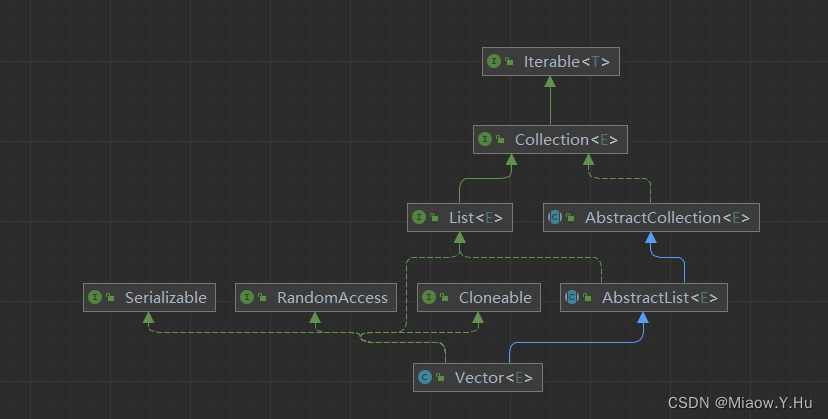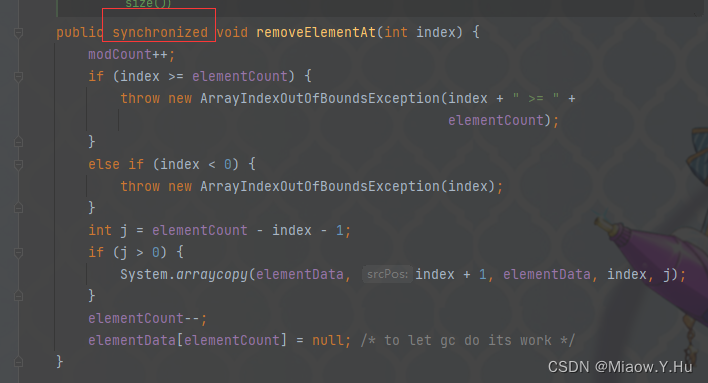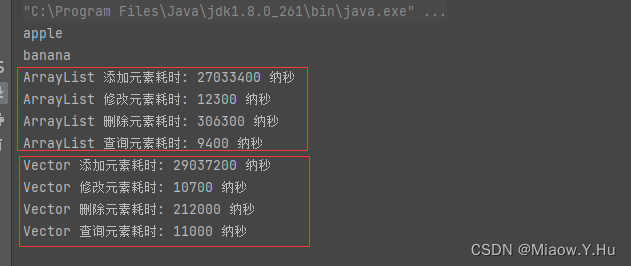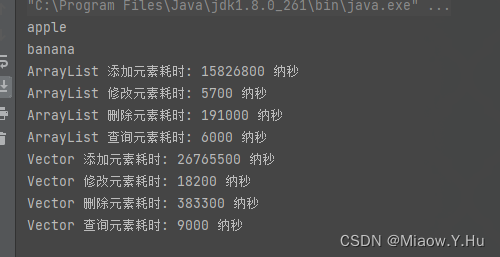java基础 - 05 Vector
Vector
学过C++的同学都知道,Vector也在C++中存在,他可以说是两种编程语言中都存在的数据结构,但是值得我们注意的是,Vector在java中和在C++中是存在差别的,在Java中,Vector是一个数组。并且他是动态的,可以自动调整大小且容纳新的元素,他实现了List接口,提供了许多方便的方法来操作元素,诸如添加,修改,删除,等等,Vector在Java中还保持着线程安全的特点·,也就是说,多个线程可以同时访问和修改Vector的内容。

如果你看过Vector源码的情况下,你应该知道Vector为啥可以保证线程安全,涉及到增删改查的操作,在Vector中均使用了synchronized 来修饰,synchronized给他加锁了,那能不安全嘛!
如下图所示:

Vector的使用情况
如果你是在开发岗位的开发者,你应该会发现,我们的Vector在C++中使用频繁,但是在Java中我们用起来就很少了,这是为什么呢?
原因在于,我们的Vector在实现线程的时候,会带来额外的性能开销,在单线程的环境下,我们作为Java开发者更加喜欢ArrayList,在单线程的情况下,ArrayList查询会比Vector更加高效。此外,Java提供了更加先进的并发集合类,例如ConcurrentLinkedQueue以及上篇我们介绍的CopyOnWriteArrayList,他们在多线程的环境下比Vector更加具有性能优势。
至于为啥Java中的ArrayList会比Vector更加高效,这是由于Vector在实现线程安全的过程中,会带来额外的性能开销,但是因为ArrayList并不具备线程安全的特性,所以其在单线程的情况下其性能更高。
- 修改元素
对于修改元素,两者的效率是相同的,都是O(1)。
- 删除元素
对于删除元素,Vector和ArrayList的效率都是O(n),其中n是元素的数量。但是,如果删除的元素在列表的末尾,ArrayList的效率会更高,因为它不需要移动其他元素。
- 添加元素
对于添加元素,Vector和ArrayList的效率都是O(1),但是如果添加元素导致容量不足,Vector会自动增加容量,这会带来额外的性能开销。
- 查询元素
对于查询元素,两者的效率都是O(1)。
但如果是在单线程的情况下,建议还是使用ArrayList,具体原因,我们可以通过一个案例进行分析:
public static void main(String[] args) {
Vector<String> vector1 = new Vector<>();
vector1.add("apple");
vector1.add("banana");
for (String line : vector1) {
System.out.println(line);
}
// 使用ArrayList进行操作
ArrayList<Integer> arrayList = new ArrayList<>();
// 添加元素
long startTime = System.nanoTime();
for (int i = 0; i < 1000000; i++) {
arrayList.add(i);
}
long endTime = System.nanoTime();
long arrayListAddTime = endTime - startTime;
System.out.println("ArrayList 添加元素耗时: " + arrayListAddTime + " 纳秒");
// 修改元素
startTime = System.nanoTime();
arrayList.set(500000, 999);
endTime = System.nanoTime();
long arrayListSetTime = endTime - startTime;
System.out.println("ArrayList 修改元素耗时: " + arrayListSetTime + " 纳秒");
// 删除元素
startTime = System.nanoTime();
arrayList.remove(500000);
endTime = System.nanoTime();
long arrayListRemoveTime = endTime - startTime;
System.out.println("ArrayList 删除元素耗时: " + arrayListRemoveTime + " 纳秒");
// 查询元素
startTime = System.nanoTime();
int element = arrayList.get(500000);
endTime = System.nanoTime();
long arrayListGetTime = endTime - startTime;
System.out.println("ArrayList 查询元素耗时: " + arrayListGetTime + " 纳秒");
// 使用Vector进行操作
Vector<Integer> vector = new Vector<>();
// 添加元素
startTime = System.nanoTime();
for (int i = 0; i < 1000000; i++) {
vector.add(i);
}
endTime = System.nanoTime();
long vectorAddTime = endTime - startTime;
System.out.println("Vector 添加元素耗时: " + vectorAddTime + " 纳秒");
// 修改元素
startTime = System.nanoTime();
vector.set(500000, 999);
endTime = System.nanoTime();
long vectorSetTime = endTime - startTime;
System.out.println("Vector 修改元素耗时: " + vectorSetTime + " 纳秒");
// 删除元素
startTime = System.nanoTime();
vector.remove(500000);
endTime = System.nanoTime();
long vectorRemoveTime = endTime - startTime;
System.out.println("Vector 删除元素耗时: " + vectorRemoveTime + " 纳秒");
// 查询元素
startTime = System.nanoTime();
element = vector.get(500000);
endTime = System.nanoTime();
long vectorGetTime = endTime - startTime;
System.out.println("Vector 查询元素耗时: " + vectorGetTime + " 纳秒");
}


一次效果可能不是很明显,我们多试试几次,在得结论,在单线程情况下。我们的ArrayList还是要比Vector的效率更高,当然这个还得你自己慢慢对比,对测试几次,在得出结论。知道注意的是,实际情况下的性能会收到多种因素的影响,比如硬件,JVM实现等情况。
Vector的常见方法
Vector的具体方法如图所示,我们不一一进行讲解了,我们就围绕简单的几个进行讲解,也是我们在实际开发中用的较多的几个方法。

结合源码进行分析:
成员变量

构造方法
/**
*使用指定的初始容量和容量增量构造一个空的向量。
*/
public Vector(int initialCapacity, int capacityIncrement) {
super();
if (initialCapacity < 0)
throw new IllegalArgumentException("Illegal Capacity: "+initialCapacity);
this.elementData = new Object[initialCapacity];
this.capacityIncrement = capacityIncrement;
}
/**
* 使用指定的初始容量和等于零的容量增量构造一个空向量。
*/
public Vector(int initialCapacity) {
this(initialCapacity, 0);
}
/**
*构造一个空向量,使其内部数据数组的大小为 10,其标准容量增量为零。
*/
public Vector() {
this(10);
}
/**
* 构造一个包含指定 collection 中的元素的向量且按迭代器返回元素的顺序排列。
*/
public Vector(Collection<? extends E> c) {
elementData = c.toArray();
elementCount = elementData.length;
// c.toArray might (incorrectly) not return Object[] (see 6260652)
//c.toArray有可能返回的不是Object[]类型,
if (elementData.getClass() != Object[].class)
elementData = Arrays.copyOf(elementData, elementCount, Object[].class);
//Arrays.copyOf(elementData, elementCount, Object[].class);这个方法就是用来创建1个Object[]数组,这样数组中就可以存放任意对象了。
}
boolean add(E e): 将指定元素添加到此向量的末尾。
public synchronized boolean add(E e) {
//修改次数+1
modCount++;
//扩容
ensureCapacityHelper(elementCount + 1);
//元素放到向量末尾
elementData[elementCount++] = e;
return true;
}
//保证容量足够
private void ensureCapacityHelper(int minCapacity) {
//获取现有数组大小
int oldCapacity = elementData.length;
//若要求的最小容量大于现有容量,进行扩容
if (minCapacity > oldCapacity) {
Object[] oldData = elementData;
//若设置了增量则为现有容量大小+增量,否则现有容量*2
int newCapacity = (capacityIncrement > 0) ?
(oldCapacity + capacityIncrement) : (oldCapacity * 2);
//若计算后的扩容容量都不满足最小容量要求,本次扩容到最小容量
if (newCapacity < minCapacity) {
newCapacity = minCapacity;
}
//进行扩容并数组复制
elementData = Arrays.copyOf(elementData, newCapacity);
}
}
对源码进行相关分析可知,synchronized保证新增同步,扩容方案为:先计算预期扩容大小(容量增量>0,则预期为:现有容量+容量增量,否则为:现有容量*2),计算后与要求的最小容量比较,取最大值。
之所以有计算预期扩容大小,是因为每次add时,扩容为现有容量+要新增的元素个数,如果每次都扩容到刚刚好放所有新元素,则每次都需要扩容,进行数组复制,性能会比较差。
void add(int index, E element): 在此向量的指定位置插入指定的元素。
public void add(int index, E element) {
insertElementAt(element, index);
}
public synchronized void insertElementAt(E obj, int index) {
//修改次数+1
modCount++;
//数组越界检查
if (index > elementCount) {
throw new ArrayIndexOutOfBoundsException(index
+ " > " + elementCount);
}
//扩容
ensureCapacityHelper(elementCount + 1);
//向量扩容并复制
System.arraycopy(elementData, index, elementData, index + 1, elementCount - index);
//设置指定索引元素为新元素
elementData[index] = obj;
//容量元素数+1
elementCount++;
}
boolean addAll(Collection c) :将指定 Collection 中的所有元素添加到此向量的末尾,按照指定 collection 的迭代器所返回的顺序添加这些元素。
public synchronized boolean addAll(Collection<? extends E> c) {
//修改次数+1
modCount++;
//获取collection数组
Object[] a = c.toArray();
int numNew = a.length;
//扩容
ensureCapacityHelper(elementCount + numNew);
//元素数组复制,扩容,并将添加到向量末尾
System.arraycopy(a, 0, elementData, elementCount, numNew);
//更新元素数
elementCount += numNew;
//返回是否新增了元素
return numNew != 0;
}
E get(int index):返回向量中指定位置的元素
public synchronized E get(int index) {
//数组边界检查
if (index >= elementCount)
throw new ArrayIndexOutOfBoundsException(index);
return (E)elementData[index];
}
E set(int index, E element):用指定的元素替换此向量中指定位置处的元素。
public synchronized E set(int index, E element) {
//数组边界检查
if (index >= elementCount)
throw new ArrayIndexOutOfBoundsException(index);
//获取对应索引原有元素值
Object oldValue = elementData[index];
//设置新的元素值
elementData[index] = element;
//返回原有元素值
return (E)oldValue;
}
boolean remove(Object o):引用块内容移除此向量中指定元素的第一个匹配项,如果向量不包含该元素,则元素保持不变。
public boolean remove(Object o) {
return removeElement(o);
}
public synchronized boolean removeElement(Object obj) {
//修改次数+1
modCount++;
int i = indexOf(obj);
if (i >= 0) {
removeElementAt(i);
return true;
}
return false;
}
/**
*返回此向量中第一次出现的指定元素的索引,如果此向量不包含该元素,则返回 -1。
*/
public int indexOf(Object o) {
return indexOf(o, 0);
}
/**
*返回此向量中第一次出现的指定元素的索引,从 index 处正向搜索,如果未找到该元素,则返回 -1。
*/
public synchronized int indexOf(Object o, int index) {
if (o == null) {
//元素为NULL
for (int i = index ; i < elementCount ; i++)
if (elementData[i]==null)
return i;
} else {
for (int i = index ; i < elementCount ; i++)
if (o.equals(elementData[i]))
return i;
}
return -1;
}
这里有个判断为空,之所以判断元素是否为空,主要是为了NULL与“==”进行匹配,否则使用equals,主要目标是避免Null也使用看equals会出现的空指针异常。
E remove(int index): 移除此向量中指定位置的元素。
public synchronized E remove(int index) {
//修改次数+1
modCount++;
//数组边界检查
if (index >= elementCount)
throw new ArrayIndexOutOfBoundsException(index);
//获取原有数值
Object oldValue = elementData[index];
//计算要移动的元素数
int numMoved = elementCount - index - 1;
if (numMoved > 0)
//复制元素,并将元素整体前移一位,从索引index+1开始
//此时倒数第二个元素和末尾元素相同
System.arraycopy(elementData, index+1, elementData, index,
numMoved);
//设置末尾为空,等待垃圾回收
elementData[--elementCount] = null; // Let gc do its work
//返回被移除的元素
return (E)oldValue;
}
boolean removeAll(Collection c):从此向量中移除包含在指定 Collection 中的所有元素。
public synchronized boolean removeAll(Collection<?> c) {
//调用的父类(AbstractList)的父类(AbstractCollection)
return super.removeAll(c);
}
/**
* 移除此 collection 中那些也包含在指定 collection 中的所有元素(可选操作)。
*/
public boolean removeAll(Collection<?> c) {
boolean modified = false;
Iterator<?> e = iterator();
while (e.hasNext()) {
if (c.contains(e.next())) {
e.remove();
modified = true;
}
}
return modified;
}
本文来自互联网用户投稿,该文观点仅代表作者本人,不代表本站立场。本站仅提供信息存储空间服务,不拥有所有权,不承担相关法律责任。 如若内容造成侵权/违法违规/事实不符,请联系我的编程经验分享网邮箱:chenni525@qq.com进行投诉反馈,一经查实,立即删除!
- Python教程
- 深入理解 MySQL 中的 HAVING 关键字和聚合函数
- Qt之QChar编码(1)
- MyBatis入门基础篇
- 用Python脚本实现FFmpeg批量转换
- 全国“兽医”专业大学生知识竞赛策划方案
- Python - 搭建 Flask 服务实现图像、视频修复需求
- itk和sitk的一些应用整理
- 力扣题:子序列-12.29
- mac安装miniconda
- vue3路由和网页标题的国际化
- python爬虫01-爬虫介绍
- 数组简单题| 盛最多水的容器、买卖股票的最佳时机、只出现一次的数字、多数元素、移动零、找到所有数组中消失的数字
- 获取当前进程cpu瞬时占用[linux][windows][c++]
- CTO直接辞退了一名架构师